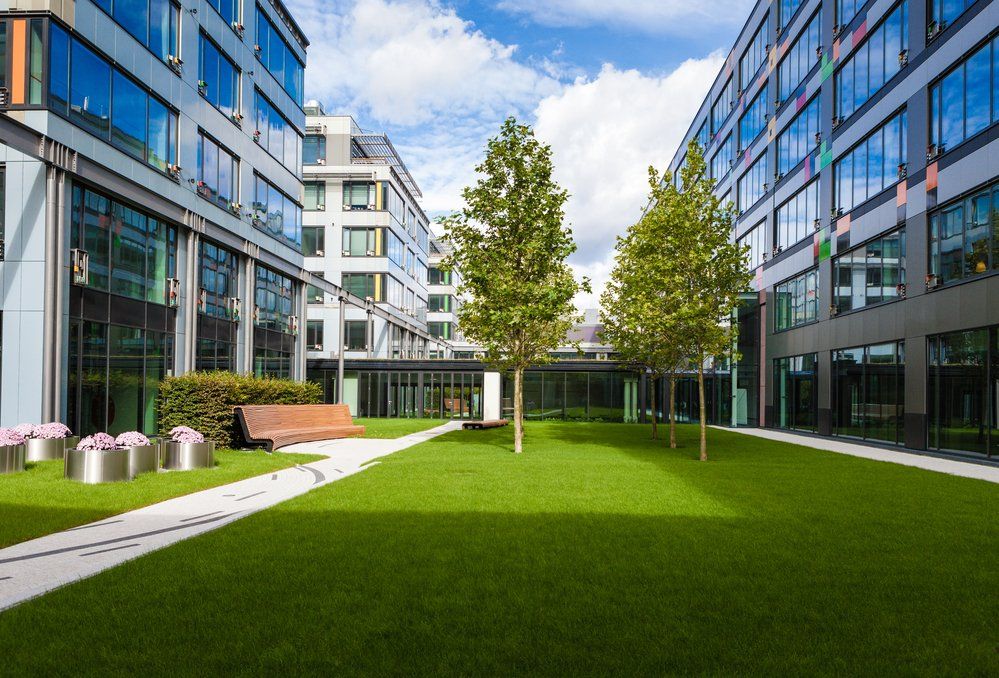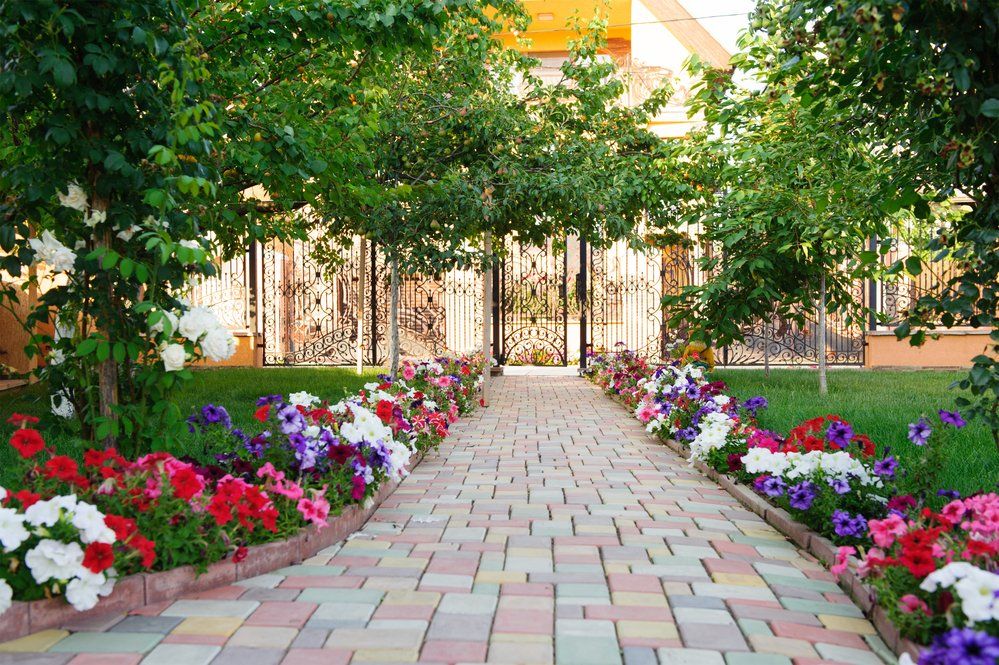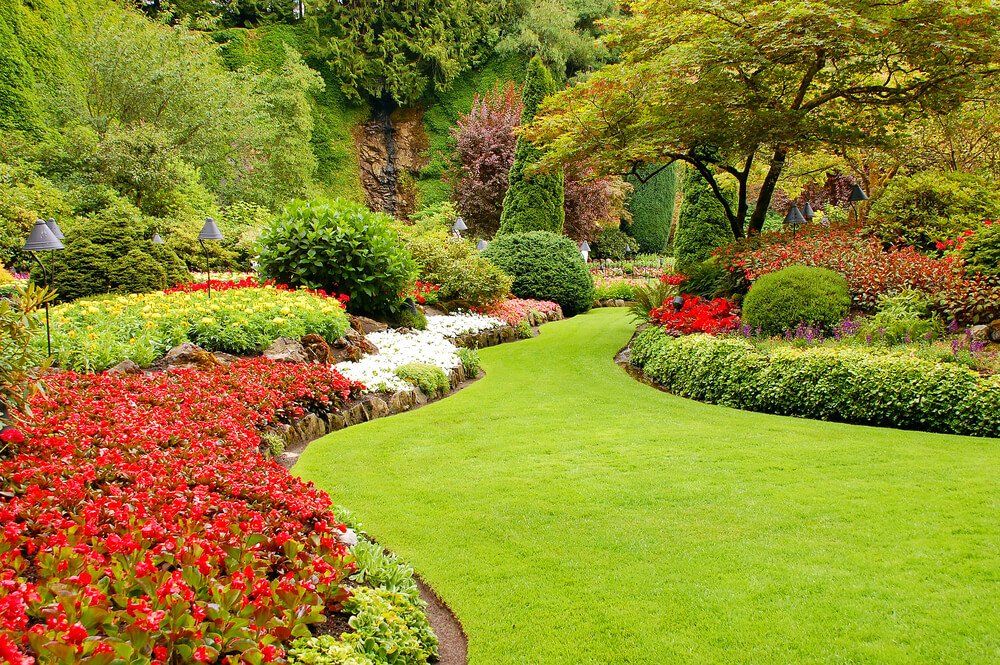The Seven Principles of Landscape Design
Tom Xu • October 14, 2021
What Are the Seven Principles of Landscape Design?
You need to incorporate different elements to add depth and functionality when designing landscapes, creating an aesthetically pleasing look for your commercial property. If you're new to commercial landscaping, it's helpful to consider the seven principles of landscape design.
Designing a property requires extensive planning and research. Learning the seven principles can help you with your first and future landscape designs.
Why Do the Seven Landscape Design Principles Exist?
The seven principles are guidelines that assist in moving the majority of landscaping ideas to specifics. The seven principles enable a designer to create a design that involves unity, cohesion, and appeal. The principles can also determine the flow, feel, and overall functionality of the plan.
You can interchange the seven principles since you can start on any step, and you will still end up with the same results. Anyone with some experience in landscape design can apply these principles to create an impact that will improve your sustainable landscaping
design.
Since you now have an overview of the principles, the next step is learning each one.
1. Simplicity
One of the seven principles of landscape designing is simplicity, valued by most designers. You don't need many elements to look fresh; you can achieve the best design by keeping it simple.
The rule is that you should remove any components from the design that don't serve a purpose. Adding too many elements can make it appear cluttered and messy, which takes away from the overall landscape. You have to prioritize the key features to keep the landscape design clean and well-appointed.
It's also important to note that the simpler the design, the easier it is to maintain.
2. Variety
The second principle out of the seven is variety. If your design is overly simplified, it will look too sparse and poorly planned. You can create an appealing landscape design by carefully choosing shapes, colors, forms, and sizes to create a diverse landscape.
However, you also have to balance simplicity and variety because adding too much can ruin the entire design. You can take a balanced approach by starting simple and then slowly adding pieces to build on the initial concept. Ensure that each element complements the key features to create a clean appearance. You can also use well-placed pieces to hide necessary components like your air and watertight access door. Use shrubbery to hide them from plain sight so that they blend seamlessly with your landscape.
3. Balance
As mentioned before, you need to even out the different elements you add to your landscape design. Everything you place in the landscape will have a visual weight, so it's best not to rush the designing process and consider every piece or element you add to the design. Many landscape designers use the mirroring technique to create a formal balance which involves placing two of the same features on each side of the landscape. You can then follow a pattern to create visual interest within the balance you've made.
If you want to try something different, consider creating an informal balance by placing equal-but-unmatching elements that side more towards the variety principle. Using this technique, you can create an impactful, sophisticated look that is original and unique to add character and flair to your property.
4. Sequence
You can never call your landscape design complete without the sequence principle. It refers to how you utilize transitions in the elements of plant texture, shape, and size. The gradual changes with a single element let you achieve an effortless, beautiful sequence. Most commercial properties consider the sequence principle when they want to improve their landscape's overall appearance. Creative sequencing is another way to increase the impact of your landscape design on your commercial property.
Note that sudden changes of one element can create an unappealing spot within your landscape, and that's why professional landscape designers
will convince you to make gradual design changes. It also preserves the vibe and feeling before you make the changes, ensuring that people can also keep up and not feel shocked about the landscape changes. You want to create a fluid design with subtle differences for an overall flow and a high-end professional look.
5. Emphasis
Many agree that emphasis is at the top of the list when discussing the seven landscape design principles. It's a principle that focuses on accentuating different areas of your landscape using color, form, or texture. It helps lead the eye towards highlights without interrupting the overall impact. However, putting too much emphasis on one element will make it appear chaotic.
An excellent tip to remember is that specimen areas work best when alone, while accent areas need to stand out, mainly when you include them in a larger design. You can also utilize key plants to minimize architectural features.
6. Scale and Proportion
The size of each element is referred to as scale, while the relation of each is called proportion. Your goal is to find the right balance. An excellent example of using scale and proportion is placing larger trees in front of a garden, which helps move the eyes towards the trees. It's a fantastic technique for an incomplete garden design since the trees are front and center; this allows you to develop the interior landscape design further.
7. Union
Finally, you can complete your landscape design when you follow the unity principle. As the name suggests, every size, element, shape, color, or form must be in unison to create the best landscape. You can also achieve union by placing walkways, pathways, and fences to link one area within the landscape to another. It's an applicable method for large landscapes that needs division for each element placed during the designing phase.
The unity principle will come with repetition since it is a design aspect that happens in many areas. Ensure you don't use too much repetition as it might turn into dominance, making your other landscape elements useless.
By effectively applying the seven principles of design - simplicity, variety, balance, sequence, emphasis, scale and proportion, and union - you can successfully create a professional landscape for your commercial property. Be sure to apply these principles in your next project!

Customers may expect a comprehensive range of services from professional landscapers . You may forgive some people for believing that these businesses perform routine tasks like mowing lawns and pruning trees. In truth, each landscaping contractor may provide a variety of specialized services to any client. If you are someone without a clue about the range of services a landscaper professional offers, you may want to know and understand these things first so that you'll have something to expect when you hire one. By understanding the essential services they could provide, you'll be able to set your standards for any following landscaping contractor you'll engage in the future. If you're planning to employ a professional landscaping contractor to help with your landscape design and upkeep, you should be aware of the many services available. Here are some of the most common services explained: Lawn Mowing In some regions, typical mowing contracts vary from 28 to 32 mows. You can include edging, string-trimming, and blow-off on hard surfaces frequently in mowing costs. This task is the most typical image people imagine when someone mentions the topic of landscaping. Hedging and Pruning Pruning and hedging at the appropriate time for every plant species are critical to plant bloom and health quality. You may have plants trimmed at the best period for their species by hiring a professional. Hydrangeas are an excellent example of a flower that needs some tending from a professional or a dedicated gardener. These professionals can use pruning to keep a plant's size or shape, remove diseased or dead limbs, remove spent blooms, and encourage growth. Hedging is the process of forming plants into geometric shapes. Both have a significant impact on the terrain. General Bed Detailing and Maintenance They must include debris removal, monitoring, weeding, removal of spent flowers, ground-cover trimming or control, and removal of browning leaves and branches in their service. It is a must-have service since it guarantees that your yard's curb appeal remains all year round. Plant Health Care (PHC) Plants get their nutrients from the soil. Some plants require more nutrients compared to others. It implies they extract a large portion of nutrients from the earth—an excellent example of these "heavy feeders" are Boxwoods. If you add a plant feed or protect program to your landscaping plan ahead of time, you'll get feedings tailored to your soil and plants. You'll also get illness and pest protection for the most prevalent problems to avoid them. This service can include bagworms, mildew, aphids, blackspots, and other pests. It will vary depending on your maintenance contract, but it is critical for healthy plants. Irrigation System Typically, maintenance contracts cover irrigation start-up and shut-down. Not everyone winterizes their system even though everyone turns on their irrigation system in the spring. Due to the lines not blasting any water out of it, it might freeze and expand in cold weather, which causes damage to the system. The cost of repairing the damage frequently costs more than the proper maintenance and winterizing of the system. Other contracts also include a monthly check-in to ensure that you're getting the most out of your water. Most reputable and established contractors have this proactive measure in contracts. Some may modify for optimal plant health and detect any required repairs by monitoring. Please be careful; if you have sprinklers installed near some utility areas, you need to protect those sites first. Installing gasketed access panels that prevent water from entering any utility areas involving electricity is an excellent example of protection. Consult with your trusted professional first for added advice. Leaf Removal and Mulching Most contracts may tailor leaf removal services to match a client's requirements for the number of visits. Some customers require a stop by or two each year. Due to the supplier's number of visits only comes twice a year, such clients will have leaf build-up between appointments. Some clients want up to seven removals every season so that their place remains relatively tidy throughout the fall. If you belong to one of these clients, you can talk to your service provider so you can customize this option. Similar to leaf removal and depending on the contract, mulching can occur once or twice a year. Mulch offers numerous horticultural benefits to a landscape project, including weed control, root insulation, and water retention despite its aesthetic appeal. Lawn Chemical Programs Lawn chemical programs nourish the grass while protecting it from various pests and illnesses, including brown patches, grubs, and various fungal problems. Most programs consist of five to seven steps that most contractors administer at the best time of year for your lawn. Weather patterns and irrigation impact turf; therefore, they must address this issue alongside your turf program. During stormy years, they may require additional treatments to address moisture-related problems. Seasonal Display They may include yearly flowers for spring, summer, and fall in a seasonal display. It may also consist of Christmas greenery and illumination. These services provide landscapes with a new level of impact and enjoyment as the seasons change. Typical Cost of Service Landscaping is an excellent way to increase the curb appeal and value of your property in case you want to sell it. Installing trees, bushes, and grass and building a patio with a gazebo and walkways are all examples of landscaping. Expenses vary widely, with a national average (in the US) ranging from $8,000 to $15,000. The scope of the task will determine the cost of service . Professional designs, fresh soil, grading, grass seed, plants, a patio, and a backyard pathway cost approximately $10,000 for most houses with a 14-acre lawn and landscaping. For fresh grass seed, dirt, and bushes in the front yard, the project's modest cost is approximately $3,000. Professional designs, sod , and new soil, as well as a patio, retaining wall, and gazebo, may cost $20,000. You need to ask and clarify the services you want to have with your landscaper before you sign any contracts. They have various specific services that they can offer you, and they can undoubtedly provide excellent advice for your project. Ensure that you hire a reputable contractor by doing some research. Final Thoughts Never risk the value of your property by hiring the wrong person for the job. Only consider hiring people of reputable worth with the credentials to back their claims. Landscaping is skill-based work, and it would be best to have someone who can correctly do the tasks involved. Consider doing some research before deciding anything.

Commercial buildings need to look their best because of the different people going in and out of the property. It would be best if you created an aesthetically pleasing building appearance, and you can do that by hiring the best contractors and designers. One area of your commercial property you have to maintain regularly is the landscape. You should know that the landscape is the most critical element within a commercial property. It helps in giving good impressions about the building. If you’re having difficulty creating the best commercial landscape, you can find several professional tips to achieve it.









